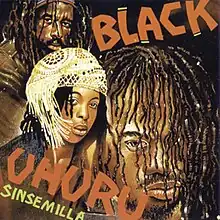| Sinsemilla | ||||
|---|---|---|---|---|
 | ||||
| Studio album by | ||||
| Released | July 1980 | |||
| Recorded | January 26, 1980 | |||
| Studio | Channel One Studios, Kingston, Jamaica | |||
| Genre | Reggae | |||
| Length | 36:43 | |||
| Label | Mango, Island, Warner Bros. | |||
| Producer | Sly Dunbar, Robbie Shakespeare[1] | |||
| Black Uhuru chronology | ||||
| ||||
| Review scores | |
|---|---|
| Source | Rating |
| AllMusic | |
| Christgau's Record Guide | B+[3] |
| The Encyclopedia of Popular Music | |
| MusicHound Rock: The Essential Album Guide | |
| The Rolling Stone Album Guide | |
Sinsemilla is the third album by Jamaican reggae band Black Uhuru, released in 1980 on the Island Records subsidiary Mango.[4] The album helped the band achieve a global fanbase.[1]
Critical reception
Trouser Press wrote that the album "delivers a level of consistency only Bob Marley himself had achieved."[7] The Miami New Times wrote that "by 1980's Sinsemilla, Black Uhuru was a paragon of politics, close harmonies, pumping grooves, and a social awareness as astute and incisive as Marley's."[8] Spin deemed Sinsemilla a "classic reggae" album, writing that Sly and Robbie's "trademark synth-drum grooves drove the group's harmonies like a diddling steam turbine."[9]
Track listing
All tracks are written by Michael Rose
| No. | Title | Length |
|---|---|---|
| 1. | "Happiness" | 4:21 |
| 2. | "World Is Africa" | 5:17 |
| 3. | "Push Push" | 4:12 |
| 4. | "There Is Fire" | 5:02 |
| 5. | "No Loafing (Sit and Wonder)" | 3:59 |
| 6. | "Sinsemilla" | 5:11 |
| 7. | "Endurance" | 4:01 |
| 8. | "Vampire" | 4:34 |
| No. | Title | Length |
|---|---|---|
| 9. | "Sinsemilla" (Discomix) | 6:30 |
| 10. | "Guess Who's Coming to Dinner" (Discomix) | 6:00 |
Personnel
- Black Uhuru
- Michael Rose - lead vocals
- Derrick "Duckie" Simpson - harmony vocals
- Puma Jones - harmony vocals
with:
- Robbie Shakespeare - bass, lead bass on "Vampire"
- Sly Dunbar - drums, percussion, electronic drums
- Ansel Collins - acoustic piano, organ
- Jimmy Becker - harmonica
- Radcliffe "Dougie" Bryan - lead guitar
- Bertram "Ranchie" McLean - rhythm guitar
- Uziah "Sticky" Thompson - percussion
- Technical
- Lister Hewan Lowe, Lowell "Sly" Dunbar, Robert "Robbie" Shakespeare - executive producer
- Ernest Hookim, Colonel Maxie (Lancelot "Maxie" McKenzie) - recording engineer
- Tony Wright - cover illustration
References
- 1 2 "Black Uhuru: Sinsemilla / Red / The Dub Factor". March 7, 2004.
- ↑ Ruhlmann, William. "Black Uhuru: Sinsemilla" at AllMusic. Retrieved 27 September 2011.
- ↑ Christgau, Robert (1990). "B". Christgau's Record Guide: The '80s. Pantheon Books. ISBN 0-679-73015-X. Retrieved August 17, 2020 – via robertchristgau.com.
- 1 2 Larkin, Colin (2006). The Encyclopedia of Popular Music. Vol. 1. MUZE. p. 638.
- ↑ MusicHound Rock: The Essential Album Guide. Visible Ink Press. 1999. p. 116.
- ↑ The Rolling Stone Album Guide. Random House. 1992. p. 63.
- ↑ "Black Uhuru". Trouser Press. Retrieved 11 March 2021.
- ↑ Stratton, Jeff (November 15, 2001). "Rare Riddims". Miami New Times.
- ↑ "Classic Reggae". SPIN. SPIN Media LLC. April 11, 2003 – via Google Books.
This article is issued from Wikipedia. The text is licensed under Creative Commons - Attribution - Sharealike. Additional terms may apply for the media files.